Picture: www.naftemporiki.gr
Creating a famous collection that saves from destruction an important part of 20th century European art, a Greek art collector looks down on the confirmation of his belief that people will need it and will appreciate it someday.

The State Museum of Contemporary Art in Thessaloniki celebrates 100 years since the birth of collector George Costakis (1913-1990), who was born in Greece, with the exhibition "The Costakis Collection and Russian Avant-garde. 100 Years After the Collector’s Birth", that was inaugurated at the Moni Lazariston cultural centre in Thessaloniki.
The curators are Maria Tsantsanoglou (Director of the Museum) and Angeliki Charistou (Costakis Collection curator). The exhibition is accompanied by organised tours, educational programmes, lectures, book presentations and a cycle of lessons with the theme Russian avant-garde. It will represent a space for dialogue for the artists who will participate in the Fourth Biennial of Contemporary Art in Thessaloniki.
The most important collection of this kind
This is the most important collection of works of Russian avant-garde (1900-1930), which is now outside Russia, constantly touring Europe. It is representative of all the Russian avant-garde schools,

one of the most interesting periods of world art that flourished in Russia during the first three decades of the 20th century.
It includes 1,277 works of art (paintings, drawings, installations, ceramics, etc.) of the most important representatives of the Russian avant-garde - Kazimir Malevich, Liubov Popova, Alexei Morgounov, Vladimir Tatlin, Nadezhda Udaltsova, Ivan Kliun, Gustav Klutsis, Solomon Nikritin, Olga Rozanova, Varvara Stepanova, Mihail Matyushin, Pavel Filonov and many others.
Gifted with a rare instinct
Born in Moscow, his father came from Zkaintos. George Costakis lived much of his life in Moscow, where he worked as a driver for the Greek and the Canadian Embassy. Accompanying foreign diplomats during their visits to Russian antique shops and homes of art, he admired Russian experimental art from the early 20th century and became interested in it. He managed to contact families and close circles of

artists, living and deceased, and, for three decades, he methodically collected works of Russian avant-garde. Of course, he encountered many difficulties, since the Stalinist regime banned Russian avant-garde and imposed the dogma of socialist realism.
George Costakis left Moscow in 1977 and settled in Greece, leaving the Tretyakov Gallery a large part of his collection. He died in Athens in 1990.
His collection was bought by the Greek State in 2000 and moved to the Museum of Contemporary Art in Thessaloniki.
Parallel events
Tours at 12 noon, and as of May - every Saturday: tours will be made available for visitors who bought tickets.
Virtual theatre
Visitors are able to visit, "flying" over the virtual city of the Russian avant-garde.
Information (Monday - Friday 10:00 a.m. to 4:00 p.m.): phone: 2310 589222
Lessons

Guided by employees of the Ministry of Culture, the audience will become acquainted with the Costakis collection of Russian avant-garde and will be able to follow the seven lessons that will be held from 16 April to 4 June (every Wednesday, from 5:00 p.m. to 7: 00 p.m.).
Participation fees: 40 euro (20 euro for teachers, students and unemployed). Application forms should be submitted no later than 12 April, information phone: 2310 589148.
Educational Programmes
During the exhibition, art workshops and tours will take place for all levels of education, but as of mid-April there will be a joint programme for parents and children.
Information:

State Museum of Contemporary Art - Moni Lazariston, 21, Kolokotroni Street., Stavroupoli 56430, Thessaloniki, phone: 2310 589141. The exhibition will last from 5 April – 19 December 2013; Opening hours: Tuesday-Sunday 10:00 a.m. - 6:00 p.m.